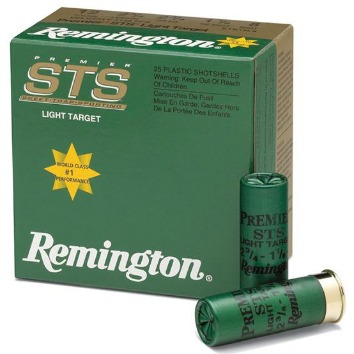|
The Good Shotgun Shell  Industry sources agree: 12 gauge shotgun shell sales account for over 82% of the market, 20 gauge shells approximately 7% of the market and the remainder is divided between the .410 bore, 10 gauge, 16 gauge and 28 gauge. High quality shotshells are important to the major brands in the marketplace, but their sales are quite small. This is apparently due to the perception that, "if it goes bang it is good enough." Pattern quality is not a consideration for many shooters, as they refuse to be bothered with patterning their guns. Brass heads are rarely used in shotshells today, with stamped steel bases now being the norm. Many people cannot tell the difference. Only three major domestic lines of shotshells use brass in their hulls: Remington STS, Winchester AA and Federal Gold Medal. Brass bases cost more, although they are easier on autoloaders by not creating the port erosion that is associated with alloy receivers and steel shell heads. As brass contracts slightly after firing, it is a better functioning shell in repeaters and easier for reloaders to re-size. The late Bob Brister is credited with saying, "The only thing more expensive than the antimony is the alimony." It is true that antimony drives up the cost of shot. The lead shot highest in antimony (6% by weight) is found in Remington STS and Nitro 27 loads. Winchester/Olin used to claim 6% for AA target loads and Federal does not often mention their antimony content, as the percentage has fluctuated a bit over the years. Currently, Gold Medal shot seems to be at or near the 6% level. As a generality, 6% antimony shot is only found in #7-1/2 and #8 target loads. Fiocchi says, "All Exacta line shells are loaded with 5% antimony lead, as opposed to the 3.2% antimony content used in Fiocchi's more economical Shooting Dynamics line of competition shells." As Neil Winston has long held, "you would be nuts to use anything but the hardest shot you can get your hands on for long yardage handicap." Being nuts is an advantage, according to some shooters; at least it is often more entertaining if you are a little bit crazy. We each get to decide what performance deficiency we choose to tolerate in our shotshells. It is easy, when walking a skeet or trap field, to find clays with one, two, or even three pellet holes in them that did not break. Here is one example: Modified choke, 2% antimony, 1-1/8 ounce payload of #7-1/2 shot = 236 pellets average in a 30 inch circle at 40 yards. Here is another example: Modified choke, 6% antimony, 1-1/8 ounce payload of #7-1/2 shot = 302 pellets average in a 30 inch circle at 40 yards. Not many people, perusing patterning results, can come up with over 20% of the pellets they would rather do without. The 6% antimony by weight figure was hardly arrived at by fortuitous happenstance. It is well known and well demonstrated that the 6% antimony percentage consistently yields the most effective patterns with #7-1/2 and #8 shot. Those familiar with Warren Johnson's Choke Chooser were invariably astonished at the very short ranges where you need a Full choke pattern percentage for an edge-on clay. Aside from antimony content, the good shotshell has pellets that are consistent in size (this requires the additional cost of careful screening) and consistent in sphericity, being as close to perfectly round as possible. If shot looks like a chef's mix of gravel, it is invariably going to fly like gravel. The fact is that antimony content matters. 4% antimony is much better than soft, 2% antimony "chilled" shot. There is no choke tube made that can turn a weak shell into a good shell, much less a great shell with a consistently high pattern percentage. No shotshell or choke tube turns anyone into a better shot. It does, however, yield a larger effective pattern diameter and that benefits all shooters, regardless of their theoretical skill level. When Dr. A. C. Jones (author of Sporting Shotgun Performance) demonstrated that those who talk of "holes" in patterns and gush that a particular gun "patterns great" are generally clueless, he ruffled a few feathers. However, he was correct. Neil Winston was also right when he showed that "reading breaks" was a waste of time, as is shooting at water, cat-tails, snow and metal gongs. Unlike patterns, the price of making a gun go bang is easily measured by the individual shooter. For this reason, the sales of good shotshells remain a comparatively small portion of the market. It is a pity, for the shotgun community wastes a staggering amount of money on back-boring, special barrels and other various and sundry items that do nothing for pattern performance. Yet, they ignore that which does give good results, namely a quality shell in concert with a quality choke. It makes no sense to bleed money for a cryogenically treated, back-bored, wonder barrel and then blow cheap, soft, misshapen pellets out of it. Is shooting more fun that way? |